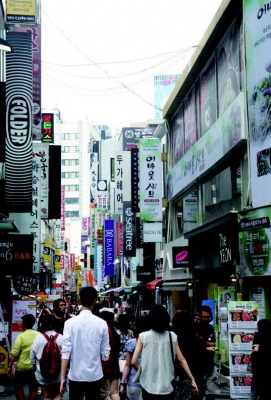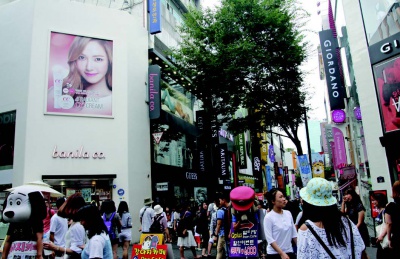Seoul - 6.2 Diverse Cultural Areas and Streets
| Understanding Korea Series No.4 | ||
| ← Previous | Seoul | Next → |
| 1) Seoul’s Symbolic Space and the Emblem of Seoul, Haechi | 2) Diverse Cultural Areas and Streets | 3) Culture of Recreation and Past Time |
Recently, the concentration of artistic resources in Seoul has produced more diverse cultural areas with unique cultural landscape or attractive cityscape. Until the 1970s and 1980s Seoul’s typical cultural area was limited to the downtown areas in Gangbuk. Now, diverse cultural areas are scattered all around Seoul. This phenomenon testifies to the fact that Seoul has passed the expansion period and has reached the maturation period. Instead of expanding outwards, Seoul is gaining differentiated landscape composed of diverse areas that are each formed based on specific resources within.
Commercial Culture Centers in Downtown
Modern commercial cultural landscape of Seoul began germinating after entertainment facilities such as movie theaters, teahouses, cafes, and bars opened up in Myeong-dong and Chungmuro where the Japanese used to reside during the Japanese Colonial Period. After the Korean War Myeong-dong gained the unique status as the cultural art center with clusters of famous fashion brand shops, galleries and performing art centers. From the 70’s, however, galleries and performing art centers started moving out of the area, and its function as the cultural art center has diminished. It still maintains its urban fashion and cultural centers today. Chungmuro, the mecca of Korean movie industry during the 60’s and 70’s, lost its old fame as the movie and fashion industries relocated to Gangnam, the center for new fashion and trend-setting. Now, it functions as a small-scale movie production center.
- Photo 28 Typical Commercial Street, Myeongdonggil
Traditional Cultural Art Areas
Insa-dong, Samcheong-dong and Daehakno areas can be seen as typical examples of areas that created unique images by clustering artistic facilities and supportive facilities such as art galleries, museums and performing art centers. Insa-dong used to be a residential area for the nobles of the Joseon Dynasty. After the Japanese Annexation Insa-dong earned its fame as a place where the ruined aristocrats deal antique calligraphies, paintings and antiques which then developed into a traditional cultural art street as the traditional painting mounting shops and facilities related to eastern-style painting moved in. The Seoul Metropolitan Government designated Insa-dong as Cultural Area in order to preserve traditional culture such as the old alleys of Insa-dong and the traditional shops found there. The usage and height of the buildings around Insadonggil street are restricted. As the number of tourists increased in recent years, Insa-dong area is quickly becoming commercialized, and the rents have skyrocketed, More cosmetics shops and fashion related stores have opened up rather than shops that sell traditional commodities.
The galleries and art museums moved to Samcheong-dong, a quieter area nearby area, as Insa-dong became increasingly more commercial. Samcheong-dong is now gaining a spotlight as the center of cultural art. But again, more shops selling consumer goods such as fashion items and shoes, cafes and restaurants have moved in, and the streets are becoming crowded with increased pedestrian traffic on the weekends. Lately, the cultural art center is shifting again towards even more secluded areas of Seochon situated on the footstep of Inwang Mountain and Pyeongchang-dong and Buam-dong near Bukhan Mountain. Particularly, Pyeongchang-dong, an exclusive residential area with excellent natural landscape, is emerging as a cultural art area with refined taste.
Seoul National University’s College of Liberal Arts and Science relocated from Daehakno, and in 1981 the Literary Art Hall and Marronnier Park were built on that site. Daehakno was designated as ‘Vehicle-free Promenade’ starting from 1985 to the 1990s and as the Cultural Street. Various cultural events such as university festivals and youth festivals were held there, and the floating population increased rapidly. After its designation as the Cultural District the number of small performing arts centers multiplied fast, and about 40% of all performing arts centers moved to Daehakno. This area has grown into a performing arts mecca as theater and production companies also increased in the area.
Leading Cultural Areas
Hongdae and Cheongdam-dong areas form the leading cultural areas that embrace diversity and interact with the new modern culture. Seoul’s modern cultural activities were first introduced to university towns where intellectuals gathered, and a unique culture was created as young people flocked together in this space. In the past popular cultural activities including poetry readings, plays and exhibitions were held in bars and teahouses, but recently a new type of cultural phenomenon, i.e. the club culture, is spreading. The streets in front of Hongdae became more energized as club culture and underground music scene joined the existing visual art industry base of publishers, galleries, small theaters, and studios.
Due to the emergence of consumerism that emphasizes cultural taste and pattern, Gangnam with clusters of trendy shops was established as the new cultural area in 1990s and 2000s. Apgujeong-dong’s Rodeo Street and Bangbae-dong’s ‘café street’ became immensely popular as the new generation preferred western style consumerism, and the phrase, ‘one needs to go to Apgujeong-dong on a windy day’ was on everyone’s lips. Cheongdam-dong area is famous as the luxury brand street; the Galleria Department Store and dozens of flagship stores of prestigious brands are located there. Sinsa-dong’s Garosugil street came to be known as the fashion and design street ever since fashion designers opened shops that also serve as studios in the 2000s. European style shops and restaurants started to open in 2007, and the floating population began to increase rapidly. This street became one of the most iconic streets of Seoul where shops with unique concepts and appearances lined up. Since Cheongdam-dong, Apgujeong-dong and Sinsa-dong came to symbolize a new cultural arena, large-scale entertainment companies that represent the Korean Wave through movies, music and photographs have gathered there to create diverse cultural activities.


